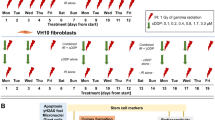Abstract
Purpose: Fludarabine monophosphate (fludarabine-P) is a relatively new drug in the treatment of different haematological diseases. The mechanism of action also implies a possible role of this drug as a radiosensitizer. Up to now no in vitro investigations dealing with radiosensitizing effects of fludarabine-P in carcinoma cell lines and fibroblasts have been published. The aim of our studies was to analyse the cytotoxic and radiosensitizing effects of different dosages and application schedules of fludarabine-P in a human squamous carcinoma cell line of the oropharynx (ZMK-1) and of fetal lung fibroblasts (MRC-5) in vitro. Possible mechanisms of interaction of fludarabine-P and radiation were investigated. Methods: ZMK-1 and MRC-5 cells were cultured under standard conditions with different concentrations of fludarabine-P in combination with escalating doses of radiation. Cytotoxic effects were measured by colony-forming assays. Induction and rejoining of radiation-induced DNA double-strand breaks after incubation with fludarabine-P were measured using constant-field gel electrophoresis. Incubation times for rejoining varied from 0 h to 24 h. Results: Fludarabine-P showed a radiosensitizing activity in ZMK-1 tumour cells and MRC-5 fibroblasts. The observed effects depended on the concentration and the incubation time. The largest effect was demonstrable for an incubation of 5 days, which started shortly before irradiation, whereas an incubation solely before irradiation did not have a clear effect on the cellular survival. The sensitizer enhancement ratio, at the 10% survival level, in the ZMK-1 cells was 2.2 in comparison to 1.6 in MRC-5 cells. The analysis of the interaction of fludarabine-P and ionising radiation by means of the isobologram approach, revealed an overadditive effect in the tumour cell line and an additive effect in the lung fibroblasts. Fludarabine-P did not modify the rejoining of radiation-induced DNA double-strand breaks in either cell line. Conclusions: We conclude that fludarabine-P in clinically attainable doses is a strong radiosensitizer in ZMK-1 cells and has a lower activity in the MRC-5 fibroblasts in vitro. The radiosensitization of fludarabine-P seems to be over additive in the malignant cells and additive in normal fetal fibroblasts. This would indicate that fludarabine-P might enhance the therapeutic ratio of radiation. Further investigations are warranted to identify the potential of this drug as a radiosensitizer in vivo and to elucidate the mechanism of interaction of the drug and radiation.
Similar content being viewed by others
Author information
Authors and Affiliations
Additional information
Received: 5 March 1998 / Accepted: 25 May 1998
Rights and permissions
About this article
Cite this article
Laurent, D., Pradier, O., Schmidberger, H. et al. Radiation rendered more cytotoxic by fludarabine monophosphate in a human oropharynx carcinoma cell-line than in fetal lung fibroblasts. J Cancer Res Clin Oncol 124, 485–492 (1998). https://doi.org/10.1007/s004320050203
Issue Date:
DOI: https://doi.org/10.1007/s004320050203



